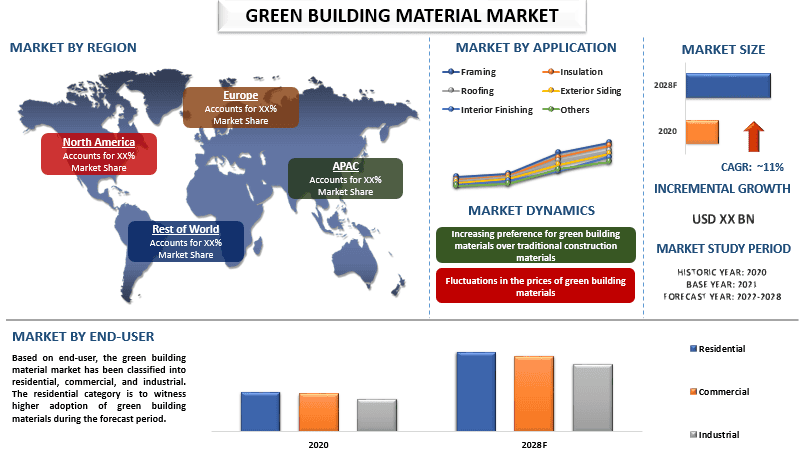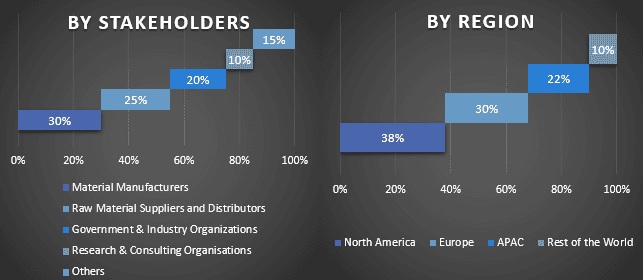Green Building Material Market: Current Analysis and Forecast (2022-2028)
Emphasis on Application (Framing, Insulation, Roofing, Exterior Siding, Interior Finishing, and Others); End-User (Residential, Commercial, and Industrial); and Region/Country

Global Green Building Material Market is expected to grow at a significant rate of around 11.2% during the forecast period. Green building material is also called an eco-friendly building material. It can be defined as the building materials used to construct a building with a low environmental impact. They are composed of renewable resources. In recent years, the demand for green building materials has risen dramatically due to the rising awareness of its benefits as well as the growing concern toward better insulation, and an eco-friendly environment. For instance, U.S. Green Building Council (USGBC) has named Hesse as the top state in Germany with the highest number of LEED-certified green buildings. Hesse is home to nearly 3 million GSM (grams per square meters) of building space comprising 95 LEED-certified projects.
BASF SE, Owens Corning, CertainTeed Corporation, Sika AG, National Fiber Supply Inc., PPG Industries Inc., Alumasc Group Plc, RedBuilt LLC, LafargeHolcim Ltd., and Kingspan Group Plc. are some of the key players in the market. Several M&As along with partnerships have been undertaken by these players to develop the green building material market.
Insights Presented in the Report
“Amongst application, insulation category to witness higher CAGR during the forecast period”
Based on application, the market is segmented into framing, insulation, roofing, exterior siding, interior finishing, and others. The insulation category is to witness higher CAGR during the forecast period owing to the growing excellent energy efficiency and increased emphasis on installing interior insulation solutions. Green building materials are being adopted to provide recycled construction of the building due to improper insulation in the buildings. Furthermore, the entry of global players into emerging markets adds to the growth of the market. For instance, CFMoto, a Chinese manufacturer of ATVs, announced its plan to launch its products in the Indian market.
“Amongst end-user, the residential to hold a significant share in the market in 2020”
Based on end-user, the green building material market has been classified into residential, commercial, and industrial. The residential category is to witness higher adoption of green building materials during the forecast period. This is mainly due to the rising number of building regulations and policies mandating energy-efficient structures. This has created a market for environment-friendly and energy-conserving materials used in residential construction. For instance, In May 2020, SmartLam North America and RedBuilt announced their partnership to supply Cross-Laminated Timber (CLT) products and solutions to architects, engineers, and contractors for projects using the popular mass timber building technology
“North America to hold a significant share in the market”
In 2020, North America is anticipated to grow at a substantial CAGR during the forecast period. This is mainly due to the regulations on environment-friendly materials used in the construction industry as emerging economies of the region are driving the growth of the market. Moreover, wide expansion of applications along with growth in the commercial and residential industry and healthcare sector is further expected to support the market growth of green building materials. In addition, the growing implementation of green building technology in many retrofitting and renovating applications further accelerates the green building material market growth in the region. Also, major players in the market continue to invest in green building materials for the construction industry with advanced use of renewable sources. For instance, in 2020, according to the U.S. Green Building Council (USGBC), 1,171 projects have been certified with LEED certification for green buildings in the U.S. with 281.05 million GSF land.
Reasons to buy this report:
- The study includes market sizing and forecasting analysis validated by authenticated key industry experts.
- The report presents a quick review of overall industry performance at one glance.
- The report covers an in-depth analysis of prominent industry peers with a primary focus on key business financials, product portfolio, expansion strategies, and recent developments.
- Detailed examination of drivers, restraints, key trends, and opportunities prevailing in the industry.
- The study comprehensively covers the market across different segments.
- Deep dive regional level analysis of the industry.
Customization Options:
The Global Green Building Material Market can further be customized as per the requirement or any other market segment. Besides this, UMI understands that you may have your own business needs, hence feel free to connect with us to get a report that completely suits your requirements.
Table of Contents
Research Methodology for the Green Building Material Market Analysis (2022-2028)
Analyzing the historical market, estimating the current market, and forecasting the future market of the global green building material market were the three major steps undertaken to create and analyze the adoption of all-terrain vehicles in major regions globally. Exhaustive secondary research was conducted to collect the historical market numbers and estimate the current market size. Secondly, to validate these insights, numerous findings and assumptions were taken into consideration. Moreover, exhaustive primary interviews were also conducted, with industry experts across the value chain of the global green building material market. Post assumption and validation of market numbers through primary interviews, we employed a top-down/bottom-up approach to forecasting the complete market size. Thereafter, market breakdown and data triangulation methods were adopted to estimate and analyze the market size of segments and sub-segments of the industry pertains to. Detailed methodology is explained below:
Analysis of Historical Market Size
Step 1: In-Depth Study of Secondary Sources:
Detail secondary study was conducted to obtain the historical market size of the green building material market through company internal sources such as annual reports & financial statements, performance presentations, press releases, etc., and external sources including journals, news & articles, government publications, competitor publications, sector reports, third-party database, and other credible publications.
Step 2: Market Segmentation:
After obtaining the historical market size of the green building material market, we conducted a detailed secondary analysis to gather historical market insights and share for different segments & sub-segments for major regions. Major segments are included in the report as application and end-user. Further country-level analyses were conducted to evaluate the overall adoption of testing models in that region.
Step 3: Factor Analysis:
After acquiring the historical market size of different segments and sub-segments, we conducted a detailed factor analysis to estimate the current market size of the green building material market. Further, we conducted factor analysis using dependent and independent variables such as various applications and end-users of all-terrain vehicles. A thorough analysis was conducted for demand and supply-side scenarios considering top partnerships, mergers and acquisitions, business expansion, and product launches in the green building material market sector across the globe.
Current Market Size Estimate & Forecast
Current Market Sizing: Based on actionable insights from the above 3 steps, we arrived at the current market size, key players in the global green building material market, and market shares of the segments. All the required percentage shares split, and market breakdowns were determined using the above-mentioned secondary approach and were verified through primary interviews.
Estimation & Forecasting: For market estimation and forecast, weights were assigned to different factors including drivers & trends, restraints, and opportunities available for the stakeholders. After analyzing these factors, relevant forecasting techniques i.e., the top-down/bottom-up approach were applied to arrive at the market forecast for 2028 for different segments and sub-segments across the major markets globally. The research methodology adopted to estimate the market size encompasses:
- The industry’s market size, in terms of revenue (USD) and the adoption rate of the green building material market across the major markets domestically
- All percentage shares, splits, and breakdowns of market segments and sub-segments
- Key players in the global green building material market in terms of products offered. Also, the growth strategies adopted by these players to compete in the fast-growing market
Market Size and Share Validation
Primary Research: In-depth interviews were conducted with the Key Opinion Leaders (KOLs) including Top Level Executives (CXO/VPs, Sales Head, Marketing Head, Operational Head, Regional Head, Country Head, etc.) across major regions. Primary research findings were then summarized, and statistical analysis was performed to prove the stated hypothesis. Inputs from primary research were consolidated with secondary findings, hence turning information into actionable insights.
Split of Primary Participants in Different Regions

Market Engineering
The data triangulation technique was employed to complete the overall market estimation and to arrive at precise statistical numbers for each segment and sub-segment of the global green building material market. Data was split into several segments & sub-segments post studying various parameters and trends in the areas of application and end-user in the global green building material market.
The main objective of the Global Green Building Material Market Study
The current & future market trends of the global green building material market were pinpointed in the study. Investors can gain strategic insights to base their discretion for investments on the qualitative and quantitative analysis performed in the study. Current and future market trends determined the overall attractiveness of the market at a regional level, providing a platform for the industrial participant to exploit the untapped market to benefit from a first-mover advantage. Other quantitative goals of the studies include:
- Analyze the current and forecast market size of the green building material market in terms of value (USD). Also, analyze the current and forecast market size of different segments and sub-segments
- Segments in the study include areas of application and end-user.
- Define and analysis of the regulatory framework for the green building material
- Analyze the value chain involved with the presence of various intermediaries, along with analyzing customer and competitor behaviors of the industry.
- Analyze the current and forecast market size of the green building material market for the major region.
- Major countries of regions studied in the report include Asia Pacific, Europe, North America, and the Rest of the World.
- Company profiles of the green building material market and the growth strategies adopted by the market players to sustain in the fast-growing market
- Deep dive regional level analysis of the industry
Related Reports
Customers who bought this item also bought










